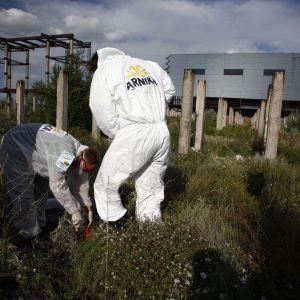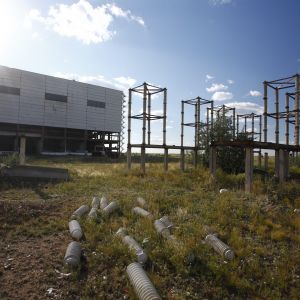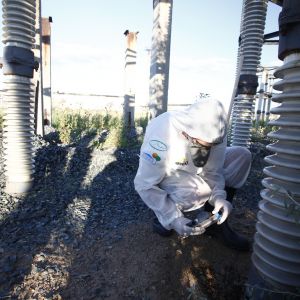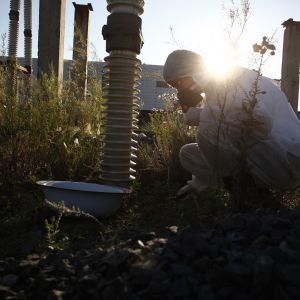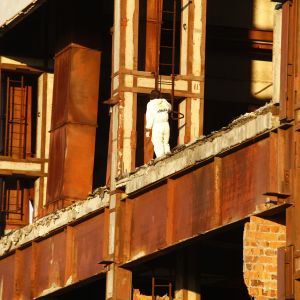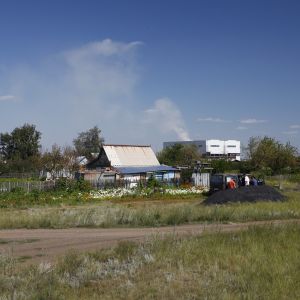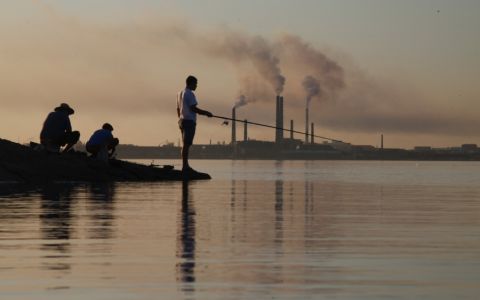There are several territories in Kazakhstan polluted by polychlorinated biphenyls (PCBs). Besides the capacitors production factory in Ust-Kamenogorsk, military radiolocation station Daryal-U at lake Balkhash, residues of extremely dangerous PCBs, we also discovered the same problem at the territory of former electric substation in the vicinity of town Ekibastuz.
The huge facility has been constructed in soviet era to transmit electricity generated by Ekibastuz coal power plant in other regions of the USSR and the countries of Council for Mutual Economic Assistance (CMEA) – for the distance of thousands kilometers. Using 15 thousand capacitors, the substation converted alternating current to direct current.
During the crisis that followed the collapse of the Soviet Union, the substation remained abandoned and unguarded. In the result, many capacitors were illegally removed, depressurized and destroyed and liquid polychlorinated biphenyls (PCBs – belonging to the group of persistent organic pollutants, POPs) have been spilled on the ground. Local people, to earn some money, were extracting non-ferrous metal from the capacitors – the copper rods.
Emergency situation
In 2001, the city found an emergency commission that was supposed to decide how to neutralize the danger arisen for people and the environment. Just next to the substation, Ekibastuz cottage settlement is located, and canal Irtysh – Karaganda flows, providing drinking water for 500 thousand city of Karaganda. It means that hazardous chemicals can contaminate the food, affect the crops, livestock and fish.
The report non-governmental organization Greenwomen “Pollution of East Kazakhstan Province and other regions of the Republic of Kazakhstan by polychlorinated biphenyls: territory monitoring and PCB sources inventory – ways of problems solution” reflects that in 2002, there were demolition works carried out at the substation. Capacitors were dismantled and sealed with foam. 50 tons of soil spilled by polychlorinated biphenyls were removed and packed in bags. After that, all waste was moved to the Semipalatinsk nuclear test site and stored in underground spaces of the “Experimental field”. 14,865 capacitors were laid on the slab in 7-8 layers, setting them on wooden pads treated with antiseptic and fire retardant impregnation. Empty spaces were filled with bags of contaminated soil from Ekibastuz substation. Burial site was fenced by wire and signs with appropriate signs were installed.
That time, described operation was called “burial of the waste”, but in 2009 burial of POPs contaminated wastes was prohibited by the Environmental Code and also by the Stockholm Convention. However, not all of the contaminated soil from the territory of the former substation was removed. PCBs were partially under concrete pillars, to which the capacitors were originally installed. The concentration of polychlorinated biphenyls here – according to the same report published by Greenwomen – reaches 26.200 mg/kg.
According to the research data of the Finnish Consulting Group (FCG) from 2010, there are four hotspots of contamination located on the territory. Two of them in the area of dismantled pillars for PCB containing capacitors (total area – 127 sq. km.). The third spot of contamination is located 200 m far from the substation and covers the area of 45 sq. km. There are no industrial buildings on this site, as well as any traces of industrial activities. How the PCBs got here remains unknown. The last contaminated spot covers the area of 90 sq. km. is also located outside of the substation and belongs to the current metallurgical enterprises "AIK". Production and administrative buildings are located in here, and also coal storage. Recheck of the territory was conducted by a private Canadian research company winning the contract of the World Bank that financed both studies.
Table. Ekibastuz: calculations of area and volume of the contaminated soil
|
Calculated data for the entire area |
Report data FCG, 2010 |
|||
|
Categories |
Area (sq.m.) |
Volume, cubic meters |
Volume, cubic meters |
|
|
Min. rating |
Max. rating |
|||
|
Hazardous waste |
3 700 |
2 800 |
6 000 |
24 000 |
|
Heavily contaminated soil |
7 000 |
5 200 |
60 000 |
180 000 |
|
Weakly contaminated soil |
16000 |
12500 |
36 000 |
110 000 |
Source of information: "Project on the proposed containment and removal PCBs and obsolete pesticides. Consulting services for additional geological survey and laboratory analysis. World Bank, Washington, SNC-Lavalin International Inc. (SLII)"
The second study came to different conclusions – only two hotspots contaminated by PCBs over the limits were found. Two samples were taken in the area where formerly pillars with capacitors were located and where spill of the oil containing PCBs happened. Contamination of the sample of groundwater slightly exceeded Kazakhstani limit for PCBs (the limit is 1 μg/l – 1.1 μg/l). In the second sample, PCBs were not found at all. The results did not confirm heavy contamination.
Thousands people under threat
Non-governmental organization EcoMuseum blames consulting companies from negligence and says that quality of the research was rather poor. None of the companies described the publish their methodology, no maps of the samplings are available and neither the exact number of samples taken. The second research was even made during winter when the soil was covered by snow – what is considered as a bad practice in sampling.
Unfortunately, polychlorinated biphenyls have the ability to slowly "crawl" and contaminate the soil. This property is especially dangerous for those PCBs areas where there are gardens and orchards, where cattle graze, and were underground water reservoirs are present. PCBs accumulate in fat, milk and then transmit through the food chain to human bodies. In the vicinity of Ekibastuz, for example, a cottage settlement is located just few hundred meters far from contaminated spot, people graze cattle here, cut the grass and produce hay. At least 5 thousand people own the cottages here. Local agricultural products are consumed by another 10 – 30 thousand people. They are not aware of the danger representing by abandoned substation in their sight.




